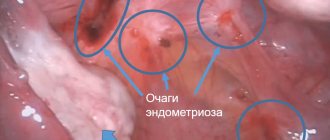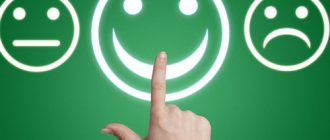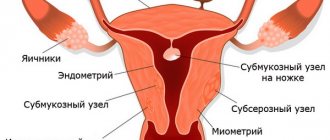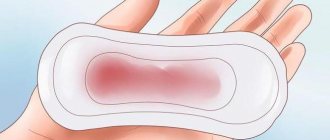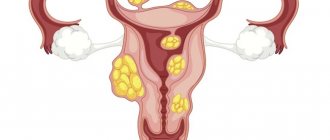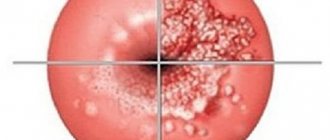Signs of uterine fibroids in combination with endometriosis
This is what fibroids look like
Myoma is a benign tumor that forms from the muscular layer of the uterus. Occurs in 70% of women of reproductive age.
Endometriosis is the growth of the mucous layer of the uterus, its spread to other organs. May be genital or extragenital. In the first case, the endometrium grows within the reproductive system, affecting the appendages, fallopian tubes, uterus, and ovaries. In the second, it affects other internal organs.
Both diseases are closely related to hormonal imbalance. In the early stages, uterine fibroids and endometriosis are almost asymptomatic. A woman often finds out about them by chance, during a routine visit to the gynecologist. At the same time, most patients with uterine fibroids and endometriosis have a common problem - the inability to conceive.
Pathologies can be suspected based on the following signs:
- painful menstruation;
- discomfort, pain in the uterus during intercourse;
- disruptions of the monthly cycle;
- intermenstrual bleeding from the uterus;
- change in the nature of menstruation (too heavy or scanty);
- nagging pain in the lower abdomen in the area of the uterus.
If you have these symptoms, you need to contact a gynecologist and undergo an examination.
Find out about the symptoms and treatment of endometriosis in women over 40.
Hyperestrogenism and other causes of the disease
Experts have still not been able to find out the exact cause of fibroids or endometriosis. The following factors are important in the development of pathology:
- Early menarche and late menopause;
- Delayed first birth;
- Numerous abortions or miscarriages;
- Refusal of breastfeeding;
- The presence of hormone-dependent diseases of the mammary glands;
- Long-term use of drugs with high estrogen content;
- Metabolic disease.
Retrograde blood flow during menstruation plays a role in the appearance of external endometriosis. It is believed that the entry of menstrual blood into the fallopian tubes provokes the appearance of heterotopias and leads to the formation of pathology. This factor plays a much smaller role in the development of adenomyosis.
All of these reasons change a woman’s hormonal background. Estrogen levels inevitably rise, and progesterone concentrations fall. Tissue proliferation is activated, which leads to the emergence of a certain group of diseases:
- Uterine fibroids;
- Endometriosis;
- Hyperplastic process of the endometrium;
- Uterine polyps.
All this pathology is united by a common term - hyperplastic diseases of the genital organs.
In the pathogenesis of hyperplastic diseases, it is not the absolute, but the relative excess of estrogen that matters. And if absolute hyperestrogenia occurs more often with hormone-producing ovarian tumors, then relative hyperestrogenia occurs when there is an imbalance of progesterone, which has an antiproliferative effect on the tissue.
https://youtu.be/NuGA6eWi3_o
Treatment of endometriosis and uterine fibroids
The choice of method depends on the age of the patient.
If a woman plans to have children, preference is given to gentle methods of treatment for uterine fibroids: medication or minimally invasive (laser cauterization, laparoscopy). Most medications, especially hormonal ones, have side effects. You should not take them without a doctor's prescription.
Hormonal drugs for uterine fibroids and endometriosis
Progesterone derivatives are mainly used: Diferelin, Buserelin, Zoladex, Milife.
Contraceptive Qlaira
Claira
Qlaira is a contraceptive pill that can be prescribed for uterine fibroids and inflammation of the endometrial mucosa. The drug contains estradiol in the same chemical form that is synthesized by the female body, and dienogest.
The package contains 28 tablets of different colors, which are designed for the treatment of uterine fibroids and endometriosis for one menstrual cycle:
- dark yellow – contain 3 mg of the hormone estradiol;
- pink - include 2 mg of estradiol and dienogest;
- light yellow - 2 mg estradiol and 3 mg dienogest;
- red – contain 1 mg of estradiol;
- white - include only auxiliary components.
The use of the drug suppresses ovulation, prevents the fertilization of the egg and its release into the uterus. In addition, it normalizes hormone balance. Due to this, endometrial foci and tumors stop developing.
Doctors prescribe Klaira to women whose uterine fibroids do not exceed 2 cm in the early stages of endometriosis, before surgical treatment to reduce pathological growths. The drug is not prescribed for the treatment of women over 35 years of age.
Prescribe Buserelin
Buserelin
A synthetic analogue of natural gonadotropin-releasing hormone, which causes a short-term increase in the level of sex hormones in the blood. Prescribed for such pathologies as infertility, uterine fibroids, painful menstruation, endometriosis. Available in the form of an injection solution, spray, drops, implants.
Once in the systemic bloodstream, Buserelin, when treating uterine fibroids, triggers complex biochemical reactions in the anterior lobe of the pituitary gland. There is a prolonged increase in sex hormones in a woman’s blood and a cessation of the production of gonadotropins. This leads to a lack of synthesis of follicle-stimulating and luteinizing hormones and a strong decrease in estradiol, which corresponds to the period of menopause or menopause.
This effect of the drug suppresses the growth of hormone-dependent uterine tumors. With long-term therapy, their reverse involution is observed. After treatment for uterine fibroids is completed, natural hormonal levels are slowly restored (within 2 to 4 months).
Buserelin is often used before surgical interventions for fibroids and endometriosis. And also in the postoperative period to prevent relapse, as part of complex treatment of breast cancer.
Spiral for treatment
Mirena hormonal device
It was originally created exclusively as a contraceptive. But when used, an effect on the uterine endometrium was found. This became the reason for prescribing the Mirena coil for uterine endometriosis and fibroids.
The product contains levonorgestrel. The hormone is localized in a special capsule, and after installing the IUD in the uterus, it is released daily into the body, ensuring the maintenance of a favorable hormonal background. The therapeutic effect is achieved due to the direct effect of levonorgestrel on the intrauterine layer.
Areas where endometrial hyperplasia is found, as well as the size of uterine fibroids, involute over time, and subsequently completely resolve.
The active substance affects the sensitivity of estrogen and progesterone, the main culprits of diseases. This prevents the development of uterine fibroids.
The woman begins to feel much better. The pain in the lower abdomen goes away, menstruation returns to normal. A pronounced positive effect is observed only at the early stage of endometriosis or with a small size of fibroids.
The contraceptive is installed for a period of 5 years. After removing the IUD, a woman can become pregnant within a year. The product does not cause rejection or allergic reactions.
Healing candles
Suppositories for fibroids and endometriosis
Preparations in the form of suppositories are not used as an independent remedy. But as part of complex therapy, suppositories with hormonal drugs show excellent results.
Prescribed for the treatment of uterine fibroids.
- Suppositories with propolis. Eliminate severe pain, inflammation, and prevent further spread of the endometrium. Propolis has an antiseptic effect and reduces the risk of infection. It helps well after surgery to accelerate tissue healing in the treatment of endometriosis and uterine fibroids.
- Ichthyol suppositories. They have an analgesic effect within 5-10 minutes after administration. Used in the later stages of the disease to relieve symptoms.
- Indomethacin. NSAIDs. Relieves pain, relieves fever, normalizes the general condition in the treatment of uterine fibroids.
- Viferon. Prescribed to prevent complications of endometriosis leading to reproductive dysfunction
- Longidaza. Indicated for indolent forms of pathology, when the risk of adhesions is high. After surgical treatment of uterine fibroids and endometriosis, suppositories speed up the healing process and prevent complications.
- Galavit. The drug is used for chronic endometriosis as a complex treatment. Active components trigger regeneration processes at the cellular level, relieve pain, intoxication, and restore the menstrual cycle.
- Terzhinan. Relieves inflammation of the reproductive system in chronic endometriosis. Quickly eliminates pain and other unpleasant symptoms.
- Antican or Endometrin. Prescribed for severe bleeding to prevent infection in the treatment of endometriosis. The drug normalizes the synthesis of hormones, has a positive effect on reproductive function, improves trophic processes in the ovaries, and resolves lesions.
Read reviews about the Mirena coil for endometriosis.
Endometrial hyperplasia
Endometrial hyperplasia is a benign growth of the inner layer of the uterus - the endometrium, leading to thickening and an increase in its volume. The process is based on the increased proliferation of glandular and stromal elements of the endometrium. Endometrial hyperplasia occurs in women of all age categories, but more often occurs in adolescence, when hormonal changes occur in the body. More often it develops against the background of an inflammatory disease of the uterine cavity and impaired sensitivity of target cells to the effects of hormones. Symptoms of endometrial hyperplasia: heavy, prolonged, frequent menstruation, irregular menstrual cycle or uterine bleeding. With endometrial hyperplasia, there may be scanty bleeding before or after menstruation, as well as in the middle of the cycle or constant bleeding for several weeks. The most common symptom of endometrial hyperplasia is sudden uterine bleeding after a long absence of menstruation, especially in perimenopausal women. As a rule, the symptoms of hyperplasia are often confused with the threat of miscarriage in the early stages and manifestations of uterine fibroids, if the diagnosis was established earlier.
Diagnosis is not difficult. The diagnosis can be made based on pelvic ultrasound performed on certain days of the menstrual cycle. The tactics are active. In such a situation, hysteroscopy is performed and the mucous membrane of the uterus is taken for histological examination.
In our clinic, we use the technology of therapeutic and diagnostic vacuum aspiration from the uterine cavity, which is more gentle and gentle in relation to the already unhealthy mucous membrane. Moreover, the technology of collecting contents by vacuum is more informative and allows you to obtain cells from hard-to-reach tubal angles of the uterus for research.
Folk remedies for the treatment of uterine fibroids and endometriosis
They can complement drug therapy and speed up recovery.
Herbal infusions, tampons on the cervix and vagina, and alcohol tinctures are used. Beekeeping products are popular. Take equal proportions of propolis and honey. The mixture is applied to a tampon, which is inserted overnight into the vagina, closer to the uterus. The procedure is done daily for 1.5 weeks, then a break for the same amount of time. The course is repeated 3-4 times.
There are reviews that small uterine fibroids were resolved after the second course with such tampons. There is no need to quit treatment. You need to complete the course in full.
Propolis candles require more time to prepare. Required:
- 100 g propolis;
- 80 g cocoa butter;
- 25 g tea tree oil;
- 150 g alcohol.
Homemade propolis candles
Preparation and use.
- Grate the propolis and add alcohol.
- Leave in a dark place for 12 days, shaking every day.
- Heat the mixture and wait until the alcohol evaporates. It should have a consistency like honey.
- Add cocoa butter, tea tree oil.
- Cool, make oblong-shaped candles, and place in the refrigerator to harden.
- Insert into the vagina daily for 10 days, then break for 5 days.
Shilajit is used as a folk treatment for endometriosis. Dissolve 2 g in a glass of water, moisten the tampon, and insert overnight.
Another recipe from camphor oil, birch tar. Make 2 mixtures:
- 1 tbsp. l. butter, camphor;
- 1 tbsp. l. butter, tar.
Alternate the mixtures, applying them to the tampon. Continue to use for 30 days, then take a 10-day break and repeat the course.
Herbs
Herbal therapy
Treatment of endometriosis and fibroids with folk remedies is not complete without plants.
- Shepherd's purse. Pour 2 tbsp. l. dry raw materials with a glass of boiling water, soak for a quarter of an hour in a water bath, cool. Strain, add water to a volume of 200 ml. Drink 1 tbsp. l. before eating.
- Herbal collection. Mix 1 part of yarrow, 2 each of bird knotweed, horsetail, rose hips, stinging nettle. 1 tbsp. l. pour a glass of boiling water over the mixture, heat in a water bath for 15 minutes, let sit for 1 hour. Take a third of a glass in the morning and evening.
- Celery juice. Squeeze the juice from the roots and leaves of the plant and mix with the same amount of honey. Drink before meals.
- Linseed oil. Use 3 tbsp daily. l., adding it to salads and food.
Contraindications for treatment
When choosing treatment tactics for uterine fibroids and endometriosis, the doctor takes into account the patient’s condition. Many women cannot take hormonal medications. Contraindications to conservative therapy:
- diseases of the digestive system;
- diabetes;
- malignant arterial hypertension;
- heart and vascular diseases;
- dysfunction of the bladder, ureter, kidneys, liver;
- individual intolerance.
Avoid saunas, hot tubs, solariums
For diseases of the female reproductive system, the application of heat to the lower back and lower abdomen, independent herbal therapy, and mud therapy are strictly contraindicated.
To avoid the development of complications, you should not stay in the sun for a long time, expose the body to excessive heat (baths, saunas), visit a solarium, or take hot baths.
Diagnostics
In this case, it is difficult to make a diagnosis based solely on the symptoms of the disease, so modern methods are used to confirm it.
Ultrasound plays a leading role among them; this method can easily confirm or refute the alleged diagnosis.
A laparoscopic method is also used, when a device is inserted into the woman’s body and a small sample of uterine tissue is taken.
Hysteroscopy is a method in which the inner surface of the uterus is examined using an optical device.
Proper nutrition (diet)
The goal of the diet for uterine endometriosis and fibroids is to slow down the process of estrogen production.
The level of the hormone depends on the amount of animal fat and the state of the immune system. It is important to normalize metabolism, since cell mutation leads to the development of a tumor, and metabolism plays an important role here. You should eat.
- Fiber. Reduces estrogen levels and the risk of developing fibroids by more than 30%. Consume at least 400 g of fruits and vegetables daily.
- Oat and wheat bran. Reduce cholesterol, remove toxins, burn fat.
- Sea fish. Source of protein and fatty acids. Use at least 3 times every 7-10 days.
- Legumes. They contain saponins and fibers that prevent cell division by affecting the process of DNA synthesis. Soy and its derivatives have pronounced antitumor properties.
- Hazelnuts, almonds, walnuts. They reduce cholesterol, increase the level of female hormones, restore cells and connective tissues, and remove toxins.
- Sprouted wheat. Contains a rich complex of amino acids, vitamins, micro- and macroelements, enzymes.
- Green tea. Eliminates the effect of free radicals, contains antioxidants and polyphenols that inhibit the growth of pathological cells.
Follow your diet, it's important

